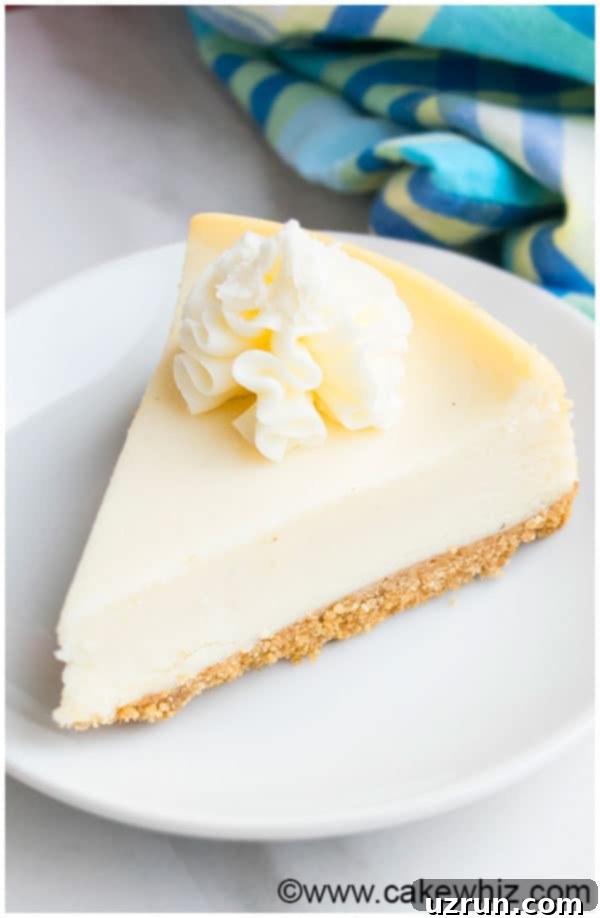The Best Classic Easy New York Cheesecake Recipe: Rich, Creamy & Crack-Free (No Water Bath Needed!)
Indulge in the ultimate dessert experience with this best-ever, classic, and incredibly easy New York cheesecake recipe. Crafted with simple, readily available ingredients, this recipe delivers an irresistibly rich and creamy texture that melts in your mouth. Forget the fuss of a water bath – this foolproof method ensures a beautiful, crack-free cheesecake every single time, topped with a luscious sour cream frosting for that perfect tangy balance. Also known simply as NY cheesecake, it’s a dessert that promises to impress with minimal effort.
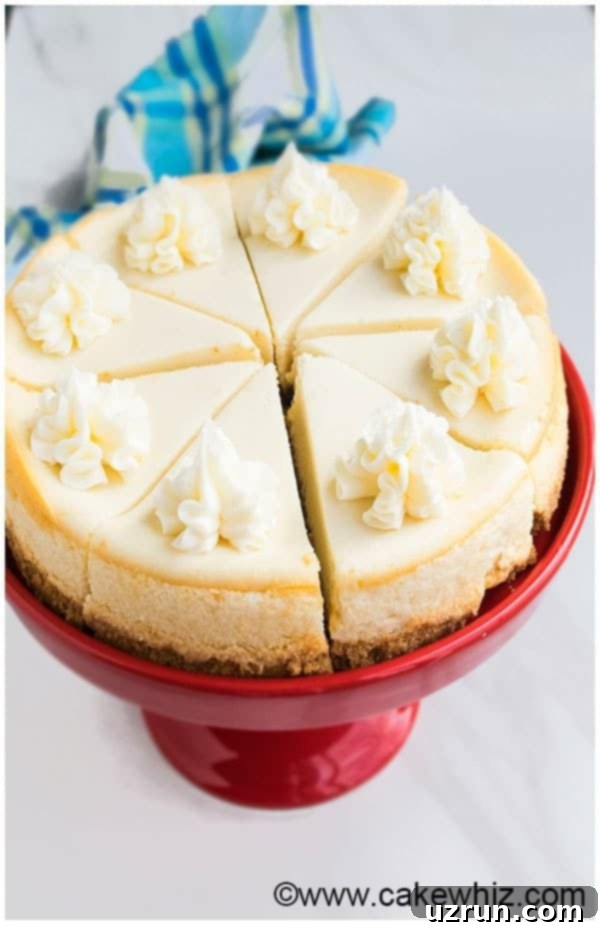
Cheesecake stands as one of the most beloved, old-fashioned, and genuinely indulgent desserts, making it a spectacular choice for parties, family gatherings, or simply a luxurious treat at home. While it often carries a reputation for being complicated and temperamental to prepare, this ultimate family recipe defies those expectations. It has been rigorously tested countless times, yielding consistently perfect results, much like our popular Pumpkin Cheesecake with Gingersnap Crust or our delightful Peanut Butter Cheesecake Bars. This recipe guarantees a cheesecake that is exquisitely rich, flawlessly smooth, and wonderfully creamy. Best of all, you can achieve this perfection without any sinking, unsightly cracks, or thick, over-browned crusts on the sides and top, as no water bath is required.
This baked cheesecake features a delightful graham cracker crust base, providing a sweet and slightly crunchy contrast to the creamy filling. The star of the show is the luscious cheese layer, meticulously crafted from an abundance of full-fat cream cheese, fresh eggs, granulated sugar, rich heavy cream, and a touch of all-purpose flour to ensure optimal texture and stability. Historically, the New York style cheesecake gained immense popularity in iconic establishments like Lindy’s and Junior’s Deli, cementing its status as a timeless American classic. Our rendition captures all the essence of these legendary versions, simplified for the home baker.
What Makes a New York Cheesecake So Special?
The distinction between a classic New York cheesecake and a “regular” cheesecake lies primarily in its signature dense, rich, and ultra-creamy texture. While many cheesecakes use a simple batter of cream cheese, sugar, and eggs, the New York version elevates this by incorporating more cream cheese, additional egg yolks, and heavy cream. This combination results in a taller, heavier, and more luxurious dessert with an unparalleled velvet-like smoothness. Often, a hint of lemon zest or juice is added to cut through the richness, providing a subtle, refreshing tang that brightens the entire flavor profile. This recipe embraces these traditional elements, delivering an authentic New York cheesecake experience right in your kitchen.
Why This Recipe is Your Go-To New York Cheesecake
- No Water Bath: This is arguably the biggest advantage. Traditional cheesecakes often require a finicky water bath to prevent cracks, but our method bypasses this entirely, saving you time and stress without compromising on quality.
- Foolproof Results: Tested numerous times, this recipe consistently delivers a perfect, crack-free, and smooth cheesecake. Say goodbye to sunken centers and uneven textures.
- Rich & Creamy: With generous amounts of full-fat cream cheese and heavy cream, the filling is incredibly indulgent and smooth.
- Simple Ingredients: You won’t need any exotic ingredients. Everything is easily found at your local grocery store.
- Classic Flavor: The combination of a buttery graham cracker crust and a tangy sour cream topping creates the quintessential New York cheesecake taste.
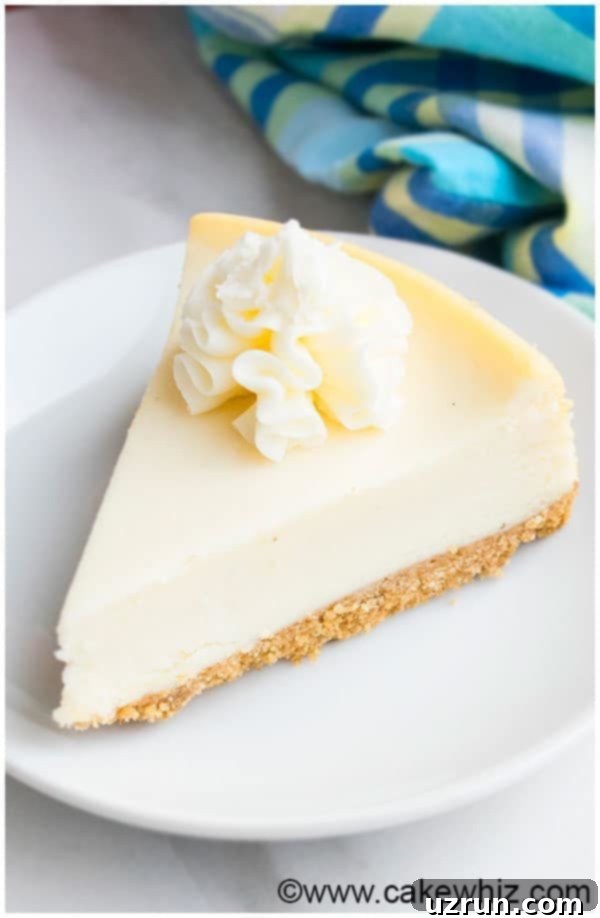
How to Make the Best Easy Homemade New York Cheesecake from Scratch?
Making this incredible New York cheesecake is simpler than you might think. Follow these straightforward steps for a dessert that tastes like it came from a gourmet bakery:
- Prepare the Graham Cracker Crust: Combine graham cracker crumbs, sugar, and melted butter. Press this mixture evenly into the bottom of a springform pan. This forms the essential crunchy base for your cheesecake.
- Whip the Cheesecake Batter: In a separate bowl, cream together softened full-fat cream cheese until perfectly smooth. Gradually incorporate eggs, additional egg yolks, vanilla extract, and granulated sugar. Finally, gently mix in a small amount of all-purpose flour and heavy cream until the batter is smooth and lump-free.
- Assemble the Cheesecake: Carefully pour the creamy cheesecake batter directly on top of the prepared graham cracker crust in the springform pan.
- Bake and Cool in Oven: Place the cheesecake in a cold oven, then turn it on to a low temperature. This gradual heating is key to preventing cracks. After baking, allow the cheesecake to cool completely inside the turned-off oven. This slow, gentle cooling process is crucial for preventing temperature shock and subsequent cracking.
- Chill Thoroughly: Once cooled, transfer the cheesecake to the refrigerator and chill for a minimum of 6 hours, ideally overnight. This firming period is essential for achieving the perfect dense texture and allowing for clean slices.
- Decorate and Serve: Just before serving, adorn your cheesecake with generous swirls of homemade sour cream frosting. Optionally, add fresh fruit, chocolate shavings, or any other topping you desire. Then, slice and enjoy your masterpiece!
Why Do Cheesecakes Crack or Sink? (Troubleshooting & Prevention)
Achieving a perfectly smooth, crack-free cheesecake can sometimes feel like a challenge, but understanding the common culprits can help you avoid these issues. There are a few primary reasons why cheesecakes might crack, split, or sink, and addressing these can lead to consistent success:
- Over-baking or High Temperatures: Cheesecakes, with their high egg content, thrive on moisture and gentle heat. Baking at too high a temperature or for too long can cause the cheesecake to dry out, leading to cracks. This also impacts the texture, making it gritty instead of smooth. Our recipe’s low and slow baking method is specifically designed to counteract this.
- Drastic Temperature Changes: One of the most common reasons for cracks is a sudden change in temperature. When a hot cheesecake is removed from the oven too quickly and exposed to a cooler environment, it contracts rapidly, causing fissures. This is precisely why I strongly recommend allowing the cheesecake to cool gradually in the turned-off oven with the door slightly ajar for at least an hour. This slow and even cooling process prevents the cheesecake from shrinking too much and cracking.
- Over-mixing the Batter: This is another frequent offender. Vigorous mixing incorporates too much air into the batter, creating numerous tiny air bubbles. During baking, these air bubbles expand and try to escape, rising to the surface and often resulting in cracks or deep indentations as they burst and the cheesecake settles. To avoid this, mix your cheesecake batter only until just combined and smooth, using a low speed.
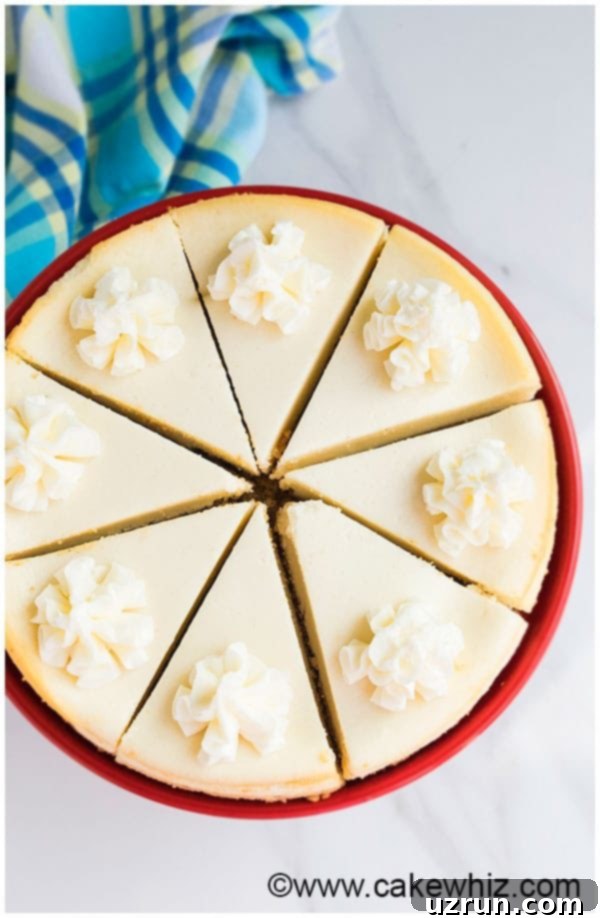
Essential Tips and Techniques for a Perfect New York Cheesecake
Crafting the perfect New York cheesecake is an art, but with these expert tips and techniques, you’ll achieve bakery-quality results every time. These simple guidelines will help you avoid common pitfalls and ensure a smooth, creamy, and crack-free dessert.
- Embrace Full-Fat Ingredients: For the ultimate creaminess and luxurious richness that New York cheesecake is famous for, always opt for full-fat cream cheese, sour cream, and butter. Low-fat or skim alternatives will significantly alter the texture and flavor, resulting in a less decadent cheesecake.
- Stick to the Baking Temperature and Time: It’s crucial not to increase the baking temperature or significantly alter the baking time specified in the recipe. The low and slow baking method is designed precisely to prevent the formation of a thick, brown crust on the top and sides, ensuring a uniformly pale and tender finish.
- Experiment with Extracts for Flavor Variations: While vanilla extract is a classic choice and provides a comforting aroma, don’t hesitate to get creative! Lemon extract, almond extract, or even a hint of rum extract can introduce exciting new flavor dimensions to your cheesecake. Just ensure the extract complements the rich, creamy base.
- Gradual Cooling in the Oven is Non-Negotiable: This step is absolutely critical for preventing cracks. If you remove the cheesecake immediately from the oven, it will cool too rapidly, causing it to shrink dramatically and form unsightly cracks on the surface. Allowing it to cool slowly within the oven as it turns off is the secret to a smooth, unblemished top.
- Thorough Chilling in the Refrigerator: Patience is a virtue when it comes to cheesecake. Chilling the cheesecake in the fridge for at least 6 hours, or preferably overnight, allows it to firm up completely. This not only enhances the density and creaminess but also makes it much easier to cut into perfectly smooth, clean slices without crumbling.
- Ensure All Ingredients Are at Room Temperature: This might seem like a small detail, but it makes a huge difference. Room temperature cream cheese, eggs, and heavy cream will blend together much more smoothly and evenly, preventing lumps and ensuring a homogeneous batter. Cold ingredients can lead to overmixing as you try to combine them, which, as discussed, can lead to cracks.
- Always Use a Springform Pan: A springform pan is designed specifically for delicate desserts like cheesecake. Its removable sides make it incredibly easy to release the baked cake without any risk of it falling apart or breaking, preserving its pristine presentation.
- Consider Making Mini Cheesecakes: For individual servings or a fun party treat, use cupcake liners in a muffin tin. Spread a thin layer of the cookie crust at the bottom of each liner, then pour the cheese batter on top. Bake for a shorter duration (adjust baking time accordingly), chill, and then frost with your chosen icing for adorable, bite-sized delights.
Delicious Cheesecake Toppings and Serving Suggestions
While this New York cheesecake is absolutely divine on its own, adding a topping can elevate it to an even more spectacular dessert. I chose to pair mine with a classic sour cream frosting, which offers a delightful tangy contrast to the rich, sweet cheesecake. You can either spread it smoothly across the entire top of the cake with a spatula or pipe elegant swirls, as I did, for a beautiful presentation.
Beyond the traditional sour cream frosting, the possibilities for toppings are endless. Here are some other popular and utterly delicious choices:
- Fresh Berries: A medley of fresh strawberries, blueberries, raspberries, or blackberries adds a vibrant burst of color and natural sweetness, along with a refreshing tartness.
- Fruit Preserves and Coulis: Spooning your favorite fruit preserves or a homemade fruit coulis (a smooth fruit sauce) over the top is a simple yet elegant option. Raspberry, strawberry, or cherry coulis are particularly popular.
- Pie Fillings: For an extra layer of flavor and texture, various pie fillings work exceptionally well. Consider these delectable options:
- Raspberry Pie Filling
- Peach Pie Filling
- Apple Pie Filling
- Strawberry Pie Filling
- Blueberry Pie Filling
- Cherry Pie Filling
- Chocolate Ganache or Shavings: A decadent chocolate ganache drizzled over the top, or a generous sprinkle of chocolate shavings, will satisfy any chocolate lover.
- Caramel Sauce: Rich, buttery caramel sauce, perhaps with a sprinkle of sea salt, offers a sophisticated and indulgent finish.
- Whipped Cream: Simple dollops of freshly whipped cream can lighten the dessert and provide a delicate counterpoint.
- Lemon Curd: For an extra citrusy kick, a layer of bright lemon curd can be truly exceptional.
When serving, ensure your cheesecake is thoroughly chilled for the cleanest slices. A warm knife dipped in hot water and wiped clean between each cut can also help achieve perfectly smooth edges.
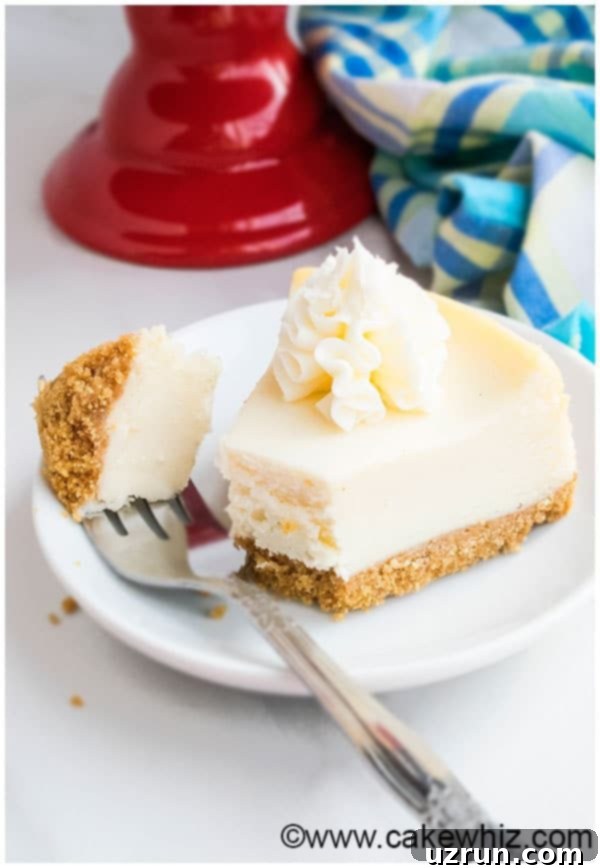
Explore More Cheesecake Creations
If you’ve fallen in love with this New York cheesecake, you’ll be delighted to know there’s a whole world of cheesecake recipes to explore! From creamy no-bake options to unique flavor combinations, here are some other fantastic cheesecake recipes to try:
- Eggnog Cheesecake (No Bake)
- Strawberry Cheesecake Cupcakes (No Bake)
- No Bake Peach Cheesecake
- No Bake Coffee Cheesecake (Mocha)
- Snowball Cake (Cheesecake Stuffed Chocolate Cake)
Recipe FAQs
Typically, you would gently shake the cheesecake, and if it jiggles slightly in only a small spot in the center but is not soupy, it’s considered to be done. However, I don’t recommend doing this for my specific recipe because the slow-and-low baking method and subsequent cooling in the oven are designed to achieve doneness without needing to test for jiggle. Opening the oven door or disturbing the cheesecake while it’s still hot can cause it to crack or collapse. Trust the process and the recommended baking/cooling times for this recipe.
A traditional or “regular” cheesecake is often simpler, with a batter typically made from just cream cheese, sugar, and eggs. The famous New York version, however, is distinctively taller, heavier, richer, and creamier. This enhanced richness comes from the addition of more cream cheese, extra egg yolks, and heavy cream, which contributes to its dense, incredibly smooth, velvet-like texture. Sometimes, it’s also subtly flavored with a touch of lemon to balance the richness. This makes New York cheesecake a truly indulgent and distinct dessert.
Leftover New York cheesecake should be stored in an airtight container in the refrigerator. This will keep it fresh and prevent it from absorbing any odors from other foods. When properly stored, it will maintain its delicious taste and texture for up to 3-4 days. For best results, allow slices to come to room temperature for about 15-20 minutes before serving to fully appreciate its creamy texture.
Yes, New York cheesecake freezes beautifully! To freeze a whole cheesecake, ensure it’s completely chilled and unfrosted. Place it on a freezer-safe plate or cardboard round, then freeze uncovered for about an hour until firm. Once firm, wrap it tightly in several layers of plastic wrap, then a layer of aluminum foil. For individual slices, freeze them on a baking sheet, then wrap each slice individually before storing in a freezer bag or container. Frozen cheesecake can last for 1-2 months. Thaw overnight in the refrigerator before serving.
Recipe
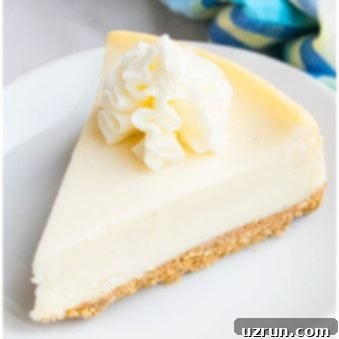
Easy New York Cheesecake Recipe
Abeer Rizvi
Pin Recipe
Want to Save This Recipe?
Enter your email & I’ll send it to your inbox. Plus, get great new recipes from me every week!
By submitting this form, you consent to receive emails from CakeWhiz
Ingredients
Graham Cracker Crust
- 1.5 cups Graham cracker crumbs
- ½ cup Granulated sugar
- ¼ cups Butter Unsalted, Melted
Cheesecake layer
- 5 packages Cream cheese Full fat, 8 oz. each
- 5 Eggs Large
- 2 Egg yolks From large eggs
- 1.5 teaspoon Vanilla extract
- 1 ¾ cups Granulated sugar
- 2 tablespoon All-purpose flour
- ¼ cup Heavy cream
Sour Cream Frosting
- ⅓ cup Butter Unsalted, Room temperature
- ½ cup Sour cream
- 1.5 teaspoon Vanilla extract
- 3 cups Powdered sugar
Instructions
-
In a mixing bowl, mix together graham cracker crumbs, sugar, butter until you have a crumbly mixture.
-
Spread this mixture in A 9 inch springform pan/ cheesecake pan and pack it down Keep aside.
-
In another mixing bowl, add cream cheese and whip until smooth.
-
Add eggs, egg yolks, vanilla extract and mix until combined.
-
Add sugar, flour and mix until well-blended.
-
Add heavy cream and mix until mixture is smooth and creamy.
-
Pour mixture in the prepared springform pan.
-
Place the pan in a NON-HEATED oven and then, turn it on and set to 200 degrees F.
-
Bake the cheesecake for 3 hours.
-
At the 3 hour mark, turn off the oven but DO NOT remove the cheesecake from the oven and DO NOT open the oven door for at least 1 hour.
-
At the 1 hour mark, remove cheesecake from oven. Cover and chill in fridge overnight or at least 6 hours.
-
While the cheesecake is chilling, prepare the sour cream frosting by mixing together butter, sour cream and vanilla extract until smooth. Gradually, add powdered sugar and mix until creamy and fluffy.
-
Prior to serving the cheesecake, decorate it with swirls of sour cream frosting. Enjoy!
Video
Notes
- Read all my tips above for the best results.
- Leftovers can be stored in a sealed container in the fridge for up to 3-4 days.
- Cheesecake can be frozen for up to 1-2 months. See FAQ section for detailed freezing instructions.
Nutrition
An automated tool is used to calculate the nutritional information. As such, I cannot guarantee the accuracy of the nutritional information provided for any recipe on this site.
